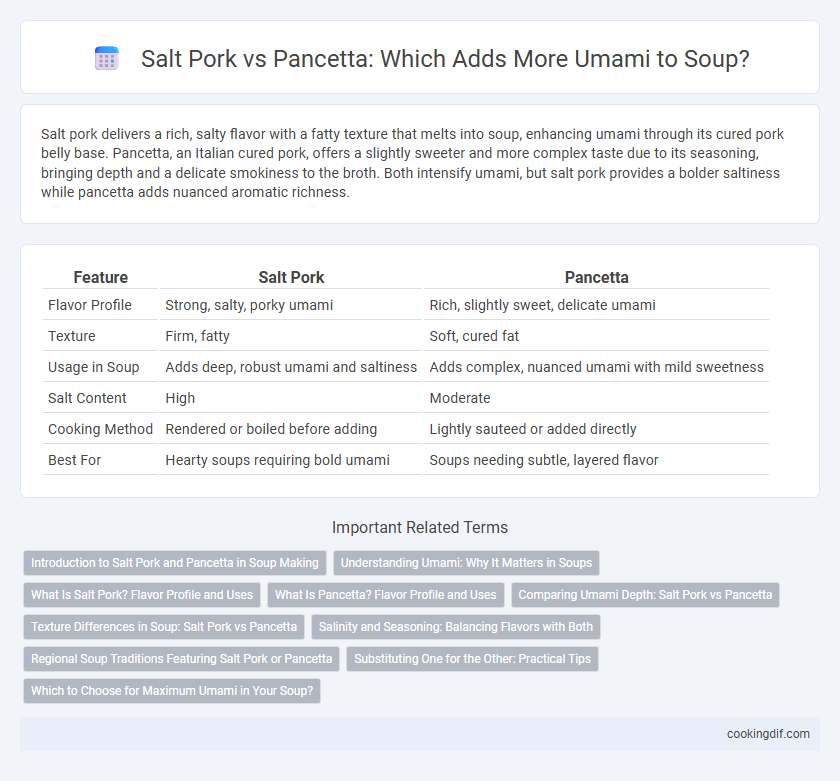Salt pork delivers a rich, salty flavor with a fatty texture that melts into soup, enhancing umami through its cured pork belly base. Pancetta, an Italian cured pork, offers a slightly sweeter and more complex taste due to its seasoning, bringing depth and a delicate smokiness to the broth. Both intensify umami, but salt pork provides a bolder saltiness while pancetta adds nuanced aromatic richness.
Table of Comparison
| Feature | Salt Pork | Pancetta |
|---|---|---|
| Flavor Profile | Strong, salty, porky umami | Rich, slightly sweet, delicate umami |
| Texture | Firm, fatty | Soft, cured fat |
| Usage in Soup | Adds deep, robust umami and saltiness | Adds complex, nuanced umami with mild sweetness |
| Salt Content | High | Moderate |
| Cooking Method | Rendered or boiled before adding | Lightly sauteed or added directly |
| Best For | Hearty soups requiring bold umami | Soups needing subtle, layered flavor |
Introduction to Salt Pork and Pancetta in Soup Making
Salt pork, a traditional cured meat, offers a robust, salty flavor and rich umami profile that enhances the depth of soups and stews through its high-fat content. Pancetta, an Italian cured pork belly, provides a delicate balance of savory and slightly sweet notes with a firm texture that melts into broths, enriching the soup's complexity. Both salt pork and pancetta are prized for imparting umami, but salt pork delivers a more pronounced saltiness and fat, while pancetta contributes subtle aromatic spices and a refined taste.
Understanding Umami: Why It Matters in Soups
Salt pork and pancetta both enhance umami in soups, but their flavor profiles differ significantly. Salt pork offers rich, salty depth with a pronounced porky savor, while pancetta contributes a delicate, cured complexity with subtle sweetness. Choosing the right ingredient impacts the soup's overall umami balance, intensifying savory notes and enriching mouthfeel.
What Is Salt Pork? Flavor Profile and Uses
Salt pork is a cured pork belly seasoned with salt, offering a robust, savory flavor with a slightly sweet undertone ideal for enhancing soups and stews. Unlike pancetta, which has a subtle spice and herb seasoning, salt pork provides a more pronounced salty umami depth, making it perfect for hearty, slow-cooked dishes. Its rich fat content renders slowly, infusing broths with intense pork flavor and a silky mouthfeel.
What Is Pancetta? Flavor Profile and Uses
Pancetta is an Italian cured pork belly known for its rich, savory umami flavor and delicate, slightly sweet undertones that enhance soups without overpowering other ingredients. Unlike salt pork, which is heavily salted and often used for its intense saltiness and fat content, pancetta provides a more balanced, aromatic depth with subtle spice notes from curing. Its versatility makes pancetta ideal for infusing broths and stocks with a complex, layered taste that elevates classic soup recipes.
Comparing Umami Depth: Salt Pork vs Pancetta
Salt pork delivers a robust, savory umami with pronounced fatty richness ideal for hearty soups, while pancetta offers a more delicate, slightly sweet and aromatic flavor profile due to its curing process. The higher salt content in salt pork intensifies the broth's depth, creating a bold, smoky undertone, whereas pancetta's nuanced complexity enhances the soup with subtle herbal and spice notes. Choosing between salt pork and pancetta depends on the desired umami intensity and flavor layering in the soup base.
Texture Differences in Soup: Salt Pork vs Pancetta
Salt pork adds a dense, fatty texture to soup, rendering slowly for a rich, gelatinous mouthfeel, while pancetta contributes a firmer, chewier bite with a slightly crisp finish when cooked. The higher fat content in salt pork melts into the broth, creating a silky, smooth consistency, whereas pancetta's cured meat fibers hold their shape, providing a more pronounced texture contrast. Choosing between salt pork and pancetta influences the soup's overall body and the complexity of its savory umami profile.
Salinity and Seasoning: Balancing Flavors with Both
Salt pork delivers a higher salinity level compared to pancetta, making it ideal for soups requiring a pronounced salty depth and robust seasoning. Pancetta offers a milder saltiness with nuanced sweetness and aromatic spices, contributing a balanced umami profile without overpowering other ingredients. Combining salt pork's intense saltiness with pancetta's subtle seasoning enhances the soup's overall flavor complexity and depth.
Regional Soup Traditions Featuring Salt Pork or Pancetta
Salt pork is a staple in New England clam chowder, imparting rich umami through its cured fat, while pancetta elevates Italian minestrone with a nuanced, savory depth from its spiced, air-dried pork belly. Regional soup traditions highlight salt pork's smoky, salty profile in Southern-style bean soups and chowders, contrasting with pancetta's sweet, aromatic qualities that define many classic Tuscan broths. Both ingredients are crucial for authentic flavor layering, enhancing the umami complexity in soups tied to their culinary heritage.
Substituting One for the Other: Practical Tips
When substituting salt pork with pancetta in soups, note that salt pork offers a higher fat content and a saltier, more intense flavor, enhancing umami with a richer mouthfeel. Pancetta, being cured but less salty, provides a subtle sweetness and aromatic depth that complements broth without overpowering it. Adjust seasoning accordingly, reducing added salt when using salt pork, and render pancetta slowly to maximize its umami contribution without bitterness.
Which to Choose for Maximum Umami in Your Soup?
Salt pork delivers a rich, savory depth with its concentrated fat and cured salt content, intensifying the umami profile of soups through slow rendering. Pancetta offers a nuanced, slightly sweet pork flavor with delicate fat that melds smoothly, enhancing complexity without overpowering other ingredients. For maximum umami impact in hearty, robust soups, salt pork is the preferred choice, while pancetta suits lighter, subtly flavored broths seeking balanced savoriness.
salt pork vs pancetta for adding umami Infographic

 cookingdif.com
cookingdif.com